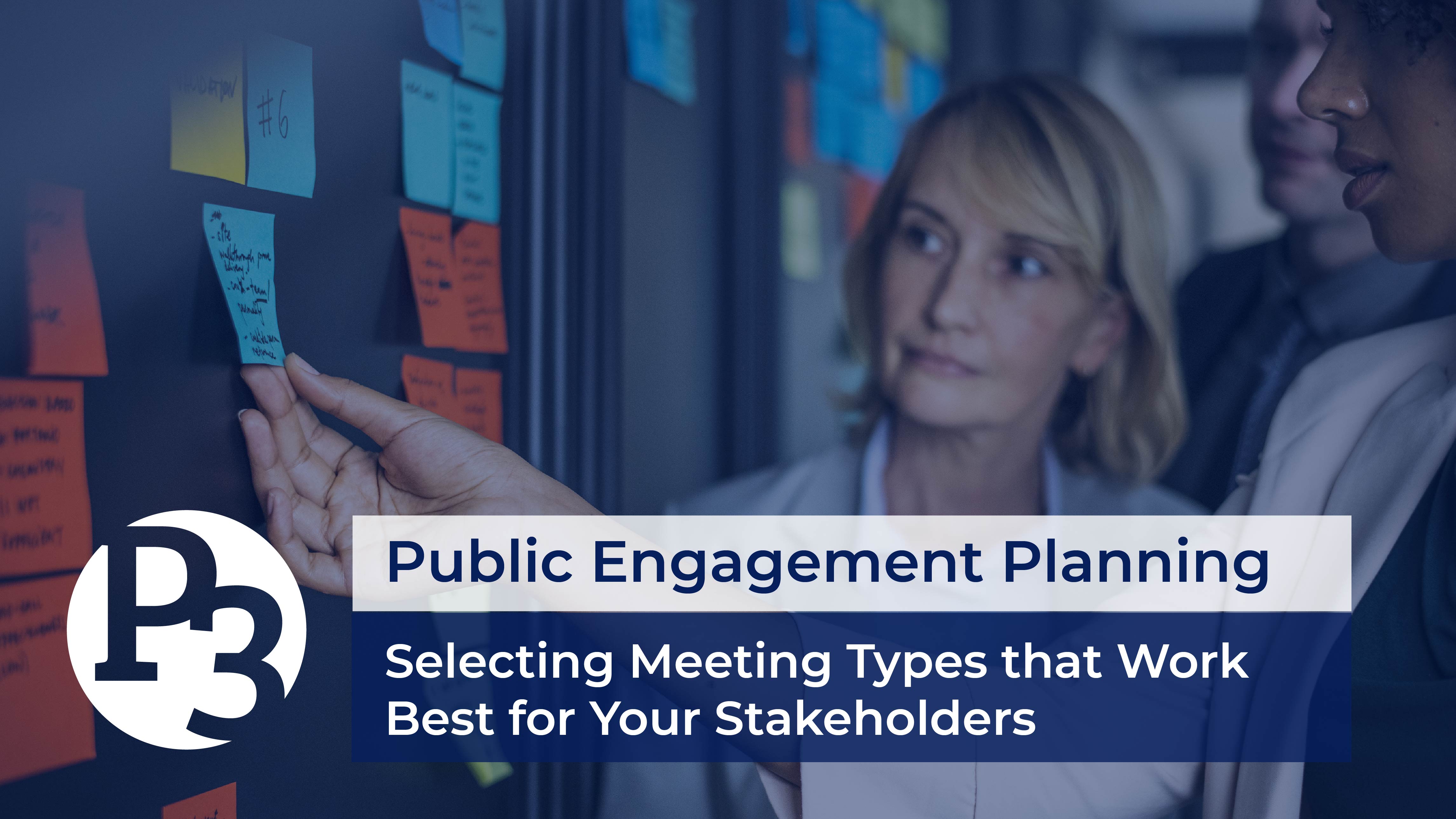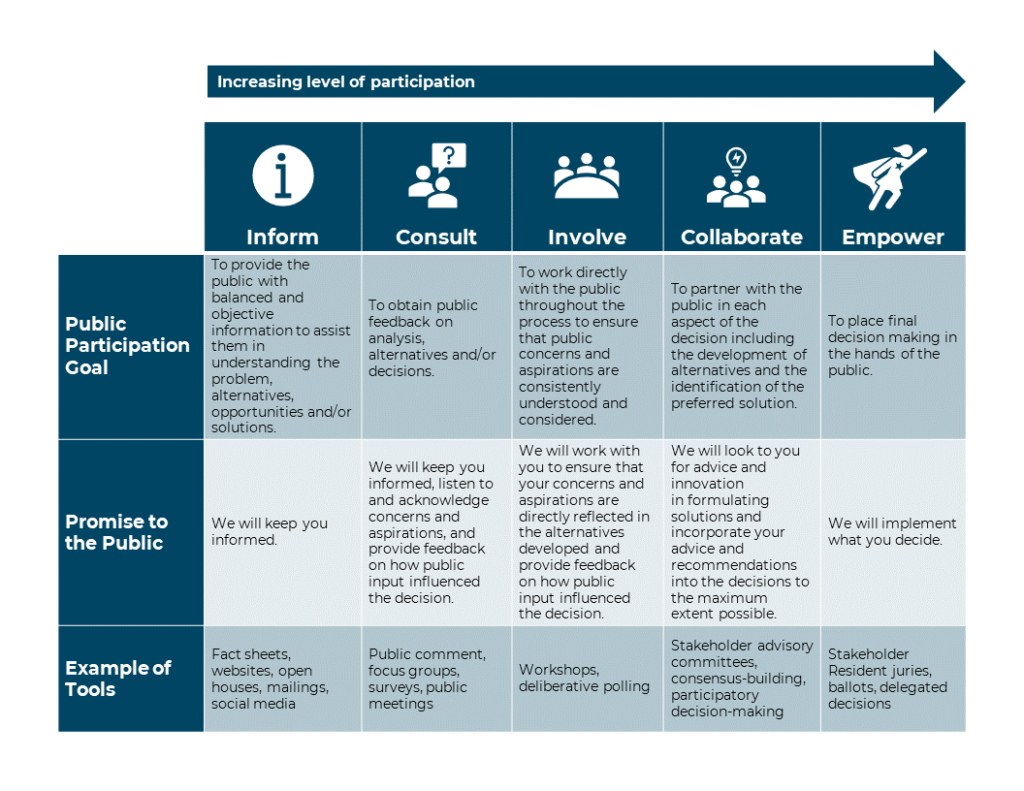
30 Oct Public Engagement Planning: Selecting Meeting Types that Work Best for Your Stakeholders
Every agency wants to make decisions in their work that factor in the needs, preferences, and concerns of the community those decisions will affect. To make sure of this, we must factor in extensive data and public input obtained through community engagement and outreach. Public engagement, involvement, and empowerment is our goal, after all!
However, it is important that you are using the most effective engagement methods to reach the public, otherwise you may not be able to gather a good amount of quality data. There is no one-size-fits-all approach to community engagement – one must incorporate a variety of meeting, feedback, and communication methods to ensure that as many people in a community are reached and are able to provide input as possible.
This post is the first in a three-part series on choosing the best engagement methods for your targeted audience and project phase. In this post, we will focus on meeting methods. There is no shortage of meeting methods to choose from when developing an engagement strategy, but your chosen meeting method should be based on budget and resource constraints, your targeted audience of stakeholders, and your engagement goals. These engagement goals may be overarching goals for your entire project, or they may be phase-specific.
Determine what level of participation you need from your stakeholders and choose meeting types based on that level.
Have you checked out the IAP2 Spectrum of Public Participation? If not, you totally should! It is a great resource for public engagement planning. This spectrum includes 5 sections, all of which are different levels of public participation:

Click here for a PDF version of the chart.
When creating a public engagement plan, your agency will decide on one of these levels of participation based on how much involvement and power the public has in the decision-making process. This level addresses the project team’s commitment to the public throughout the project. The level of participation may vary depending on the stakeholder group. Once you have decided on a level before the start of a project’s process, you will be able to select meeting types and styles that work well with the selected level of participation.
Develop a Meeting Strategy
You will want to develop a strategy for meetings that work with your decided level of participation for the project as a whole, as well as meetings that work best with the current project phase goals. Here are some important questions to keep in mind when developing this strategy:
- What level of participation applies to my audience?
- What members of the community am I trying to reach during this phase?
- What information is important to disseminate at this time?
- Are there any methods best suited for reaching my intended audience?
- Do I have the required budget and resources to achieve my goals?
After answering these questions, you will have the foundation you need to begin planning a meeting strategy. Public meetings are an excellent way to reach members of a community and keep them involved throughout the project while also collecting feedback and information from them. Further, meetings can help you build lasting relationships with members of the community, making the community engagement process mutually beneficial.
Take the time to research meeting method options and required resources for each.
There are a lot of methods out there, and some are better at reaching certain audiences and achieving certain goals than others. For example, public meetings and hearings are an excellent way to convey a lot of information, possibly through a formal presentation, to a large audience of community members. Open houses are great for reaching a large amount of people in a flexible way that allows them to come and go as needed. Focus groups allow you to reach a small group of people and gather specific feedback on questions.
The type of meeting most beneficial to you at a particular time will vary, so it is important to do your research and go into your meeting strategy planning with the knowledge needed to make informed decisions on what meetings will work best.
Offer various dates and times for meetings to give all stakeholders the chance to participate.
Not only should your meeting plan include multiple meeting types, but it should also be structured so that community members are able to participate at a time that works best for them. Include meetings on various days and at various times to ensure all that want to participate are able to.
Remember to keep in mind certain times that may not work for a large number of residents. For example, Sunday meetings are probably not beneficial as this is a day normally reserved for religious activities (unless you are incorporating a religious institution into the meeting, such as through a pop-up at a church). Meetings during the day on weekdays may also be difficult for many to attend, as residents may have work and/or school commitments.
Incorporate both traditional and virtual meeting methods.
Due to the ongoing pandemic, this has been a pretty easy strategy to keep in mind. Most engagement at this point is centered around digital methods, as in-person gatherings are not recommended in the interest of public health. However, it is important to remember that relying solely on digital engagement methods may result in a lack of reach to some members of a community that are without reliable Internet access or means to participate.
Employing a variety of in-person and virtual strategies, both during a pandemic and “normal” times, is important to include all members of a community. Even in light of the pandemic with an emphasis on distancing and reduction of public gatherings, one can still find safe methods of traditional engagement to make sure all members of a community are able to participate. Using a combination of virtual public meetings, socially distanced pop-up events, polling stations, and more will allow residents to attend meetings in a way most comfortable and convenient for them.
Keep locations in mind: choose nearby locations with ADA accessibility.
When able to start hosting in-person meetings again, it’s important to select an appropriate location. You will want to find a location within the study area if at all possible, as this should be fairly convenient for stakeholders to travel to. Speaking of travel, make sure that there are sufficient transportation options to reach the location! Locations near large neighborhoods or areas of people and locations near transit stops are excellent options to ensure interested residents can reach the meeting.
It’s also important to consider accessibility when selecting a meeting location. Is there adequate parking for those with disabilities? Are those with disabilities able to locate and navigate within the building? If not, perhaps look for a location that is more accessible.
Ask your stakeholders which meeting types and locations they prefer!
You don’t need to make assumptions about what stakeholders prefer, you can ask them directly! Send out surveys or chat during meetings and ask what meeting types, times, and locations work best for them. This shows a consideration for their time and participation as well as makes further engagement planning on your part easier!
It can be difficult to find an assortment of meeting types that work best for your project and community, but with research and diligent planning, you will be able to select methods that give you the highest turnout and better engagement and involvement!
After selecting meeting types, it’s crucial to look at feedback types to determine how you will gather information from the community you are engaging! Stay tuned for our next post to get the rundown of feedback types and how to select the best one.
TL;DR
Want to be notified when we release a new blog post? Subscribe here! And don’t forget to follow us on Facebook and LinkedIn!
About the Author: Katie Maynard started her journey with Public Participation Partners as a Community Engagement Assistant in January 2020. When not assisting with public involvement, Katie enjoys reading, traveling to the beach, and spending time with her pets.


Sorry, the comment form is closed at this time.